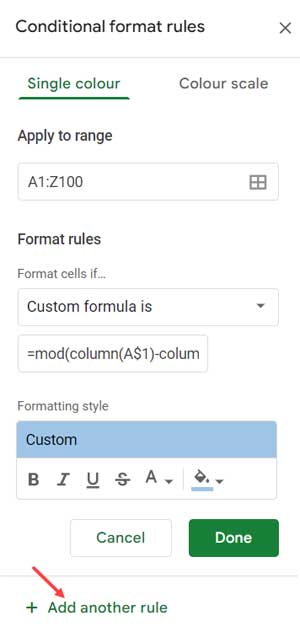In this tutorial, you will get a conditional format rule to dynamically highlight every alternate set of n columns in Google Sheets.
For example, if n = 2, with the said rules, we can highlight columns A and B with light blue color, C and D with light red color, and repeat the same.
You can control the set of n columns within a cell by referring to that cell in the formula.

Similar to highlighting every alternate set of n columns, I have a formula for the rows, which you can find here – Highlight a Set of Alternate Rows in Google Sheets.
Formula to Highlight Every Alternate Set of N Columns
We will apply the conditional format rule for an entire worksheet, i.e., in the range A1:Z1000.
Later we can adjust the formula for our required range.
I’ve used the following formula in the above example to fill the background with a light blue color.
Rule # 1:
=mod(column(A$1)-column($A$1),$A$1*2)<$A$1And the below formula for the light red.
Rule # 2: (Optional)
=mod(column(A$1)-column($A$1),$A$1*2)>=$A$1I’ll explain how to insert the above two rules to highlight every alternate set of n columns in Google Sheets.
Before that, please note that the n in the above formulas is the cell reference $A$1 which is highlighted in green.
That means you can control the number of columns in each set from cell A1.
A1 value and how it affects the highlighting:
| A1 Value | Set of Columns (Behavior) |
| 1 | Every other column |
| 2 | Every Alternate Set of 2 Columns |
| 3 | Every Alternate Set of 3 Columns |
| …and so on. |
If you don’t want dynamic behavior, then replace $A$1 with the corresponding number.
If you are a newbie, follow the below steps to set up the above two conditional format rules in Google Sheets.
Steps to Apply the Rules to Highlight Alternate Set of N Columns
First, open the file and go to the corresponding sheet tab. Then follow the steps below.
- Go to the menu Format > Conditional formatting.
- Apply to range – A1:Z1000.
- Format Rules > Format cells if > Custom formula is – enter above Rule # 1 formula.
- Format Rules > Format style – select fill color (light blue).
- Click Add another rule and edit steps 3 and 4 above. In step 3, insert the above Rule # 2 formula, and in step 4, choose the light red color.
- Click Done.
- Enter 3 in cell A1 and see what happens.

We have learned how to highlight every alternate set of N columns in Google Sheets.
Fill Color Starting From a Different Column (Other than A)
I know you may not use the above background coloring in your entire sheet.
You may want to leave a few columns in the front.
For example, keep columns A to C out of the covered area of the above highlighting rules.
So it’s crucial to know how to modify my formula to apply the fill color starting from a different column other than A.
You can use the below two formulas to highlight every alternate set of 5 columns from column D.
Light Blue:
=mod(column(D$1)-column($D$1),$A$1*2)<$A$1Light Red:
=mod(column(D$1)-column($D$1),$A$1*2)>=$A$1The Apply to the range for both the rules must start from column D, i.e., D1:Z1000.
Finally, enter 5 in cell A1.
That’s all. Thanks for the stay. Enjoy!
Resources
- How to Highlight Every Nth Row or Column in Google Sheets.
- How to Highlight Only Texts in a Column or Row in Google Sheets.
- Highlight Duplicates in Single, Multiple Columns and all Cells in Google Sheets.
- Highlight the Earliest Events Based on the Date Column in Google Sheets.
- Google Sheets: Highlight Rows When the Value Changes in Any Column.
- Highlight the Top 10 Ranks in Single or Each Column in Google Sheets.
- How to Highlight an Entire Column in Google Sheets.
- Applying Alternating Colors to Visible Rows in Google Sheets & Excel.





















